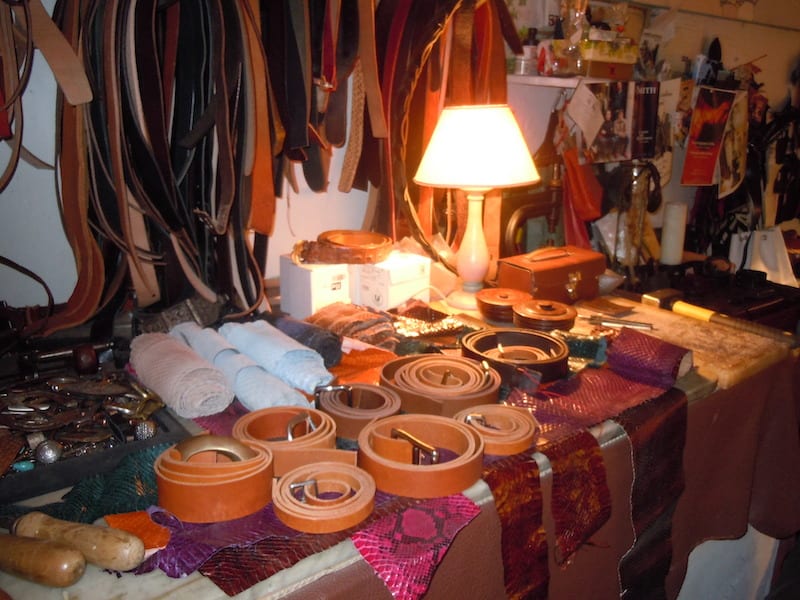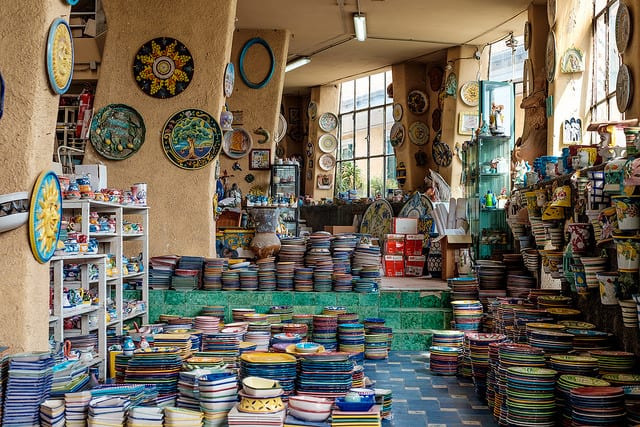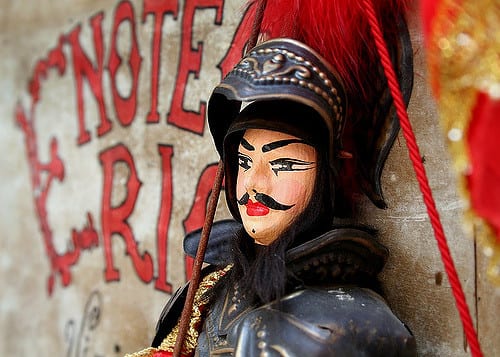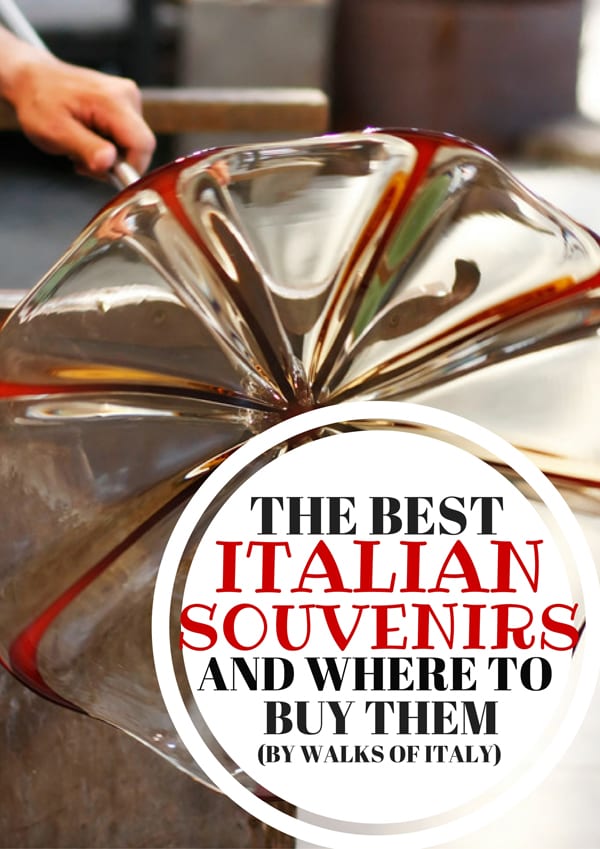
Italy has world-class souvenir shopping – and we don’t mean plastic trinkets. Think world famous markets, delicatessens packed full of local specialty foods, and the flagship stores of world-famous Italian designers. Wherever you go, Italy’s artisanal products are the stars of the show. The country has a long history of creating some of the finest hand-made goods in the world and continues to ensure that the “Made in Italy” tag a mark of superior quality.
It isn’t always easy to find authentic Italian souvenirs, but the best way to do it is by knowing where to shop. Don’t know where to start? Don’t worry! Here are the top souvenirs from Italy and where to find them.
Leather in Florence

In Monaco Metropolitano you can find belts of all types, purses and shoes – and create your own! | Photo Gina Mussio
With its famous Chianina cows and a thriving central business hub in Florence, Tuscany has all the ingredients to make excellent leather. Sitting right on the banks of the Arno River, the neighborhood of Santa Croce in Florence has been home to water-heavy trades, like hide tanning, since the 13th century and the tradition lives on today. In fact, 35% of national leather production still takes place in this area today!
Though you can find authentic Italian-quality leather throughout all of Tuscany and even nearby Umbria, Florence is still the best place to buy that incredible handmade purse, coat, or belt you’ve been dying to have.
Because leather is such big business, you’re not going to find mom and pop stores here, but you will have a plethora of choices. Head to Santa Croce to see what the biggest brands are selling, or if you only have one day in Florence take a lunchtime tour of the massive San Lorenzo Market which boasts dozens of stores and booths selling any and all leather products. Look for signs reading “Italian-quality” leather, so you know it was made according to local traditions and not chemically treated. Real leather will have imperfections and feel soft. It should be a natural color and you should be able to see the texture of the animal skin. Also, this souvenir from Italy isn’t cheap. Though you can, and in some cases should, certainly haggle, quality leather has its price!
For more info about shopping on Florence check out four of our favorite artisans in Florence’s Oltrarno neighborhood.
Glassware in Murano
Murano, an island off of the lido of Venice, has been a leader in European glassware for centuries. Because Venice was a major trading port for goods from all over the Mediterranean and the Far East, the city’s artisans developed glassmaking technologies that synthesized influences from Roman, Greek, and Asian cultures. As the industry grew, so did the threat of fire from their kilns and the government moved them to the nearby island of Murano. Eventually, the Venetian Republic became one of the dominant trading powers in Europe and the glassmakers benefited in turn. Their notable income was useful for the state and the artisans enjoyed a particularly prominent status throughout the Renaissance.
Today the glassmakers still wow visitors with their incredible skill. They can make anything from chandeliers to perfectly-sculpted earrings and bottle stoppers, all using methods originally developed in the 1200s.
Be careful when choosing your Murano glass – there are a lot of imitations out there, including some glass on the island of Murano itself! Look for well-known brands, and the Artistic Glass Murano® trademark of origin to be sure you’re getting the real deal.
Those who simply want to ogle more of the beautiful glass designs and learn about the history can visit the Museo del Vetro (Glass Museum) in the Palazzo Giustinian on Murano Island.
Ceramics in Vietri sul Mare

Vietri sul Mare is filled with shops selling the areas famous majolica pottery. | Photo by Kārlis Dambrāns
As with all Amalfi Coast towns, Vietri sul Mare enjoys great food and great views but its real claim to fame is its rich ceramics tradition. Vietri sul Mare is the cradle of Italy’s brightly colored earthenware pottery known as majolica.
Though majolica ceramics are sold throughout the Amalfi Coast, the artisans in Vietri sul Mare have taken the particular, colorful style of the centuries-old tradition and adapted it for contemporary tastes, making ceramic vases, bowls, plates, and decorations for inside and outside your home.
The ceramics are all decorated by hand, with patterns and designs that perfectly reflect the beautiful Mediterranean lifestyle found along the Amalfi Coast. Brightly colored sunflowers, lemons, grapes, and landscapes grace the fire-glazed items. Whether you want a whole set or just a showpiece, these are the perfect souvenir from Italy to give your home a touch of la bella vita! Prices are usually reasonable, though larger or shipped items will cost you more.
While visiting Vietri sul Mare, stop in the Fabbrica di Ceramiche Solimene to learn more about the ceramics tradition and more contemporary developments or pop into the Museo Provinciale della Ceramica in beautiful Villa Guariglia.
Woodwork from all of Trentino-Alto Adige
Trentino-Alto Adige is home to verdant pine forests and the jagged pink peaks of the Dolomites. It’s a place where nature and civilization coexist in pleasing harmony – a relationship evinced in their artisanal traditions. Wood from the surrounding forests is the backbone of life in Trentino, where most of the buildings are constructed from local trees like spruce, scotch pine, and larch. It’s these same woods that most often show up in handicrafts of local artisans.
The area’s woodcarving traditions originated during the long, cold winters, when entire families gathered around the stove, or stube to stay warm. They often passed the time doing something with their hands and we’re glad they did; today Trentino-Alto Adige’s woodcarvings are second to none. From benches and chairs to cutlery, cutting boards, wine holders, and other decorative objects, these are the perfect gifts to put in your home.
Marionettes from Palermo
Though puppets might have a somewhat antiquated air, the puppets and marionettes in Sicily are so intricately made you can’t help but want to take one home. Drawing on stories from the Commedia dell’Arte, Medieval Italian puppet theater was one of the forerunners of all European puppetry. Italians have always cultivated a culture of story telling, and nowhere is this truer than in a present-day puppet show. Though the stories are classics, the dialogue is made up on the spot, meaning a good performer must be able to handle his marionette and be a master of improvisation.
Today, puppet shows are performed at the Opera dei Pupi in Palermo, Sicily. Dating back to the 15th century, the marionettes depict characters straight from Southern Italy’s history. Heroes of important battles fall in love with dark-haired Sicilian beauties, while vanquishing historical foes like Saracens or Norman invaders.
The marionettes are made of wood with strings and metal wires holding them up. Though this medieval theater is constantly fighting for attention with more modern forms of entertainment, the culture and craft of Sicilian puppetry are protected as a form of intangible cultural heritage by UNESCO. Artisan shops and studios selling these classic marionettes abound in Palermo, and while quality varies, they are all incredible examples of a very unique type of cultural expression.
Learn more about bustling, intriguing Palermo with our Insider’s Guide to Palermo.
Nativity scenes and figurines from Naples
There’s no place like Naples for Christmastime. Since St. Francis invented the nativity scene, or presepe, in the 13th century, Italians have been making it their own, and Neapolitans have become the number one makers and sellers of the small scenes and accompanying figurines. They believe they do it better than anyone– and so do many Italians.
Even if you aren’t able to visit the city during Christmastime, you can still see this artisan craft up-close. Visit the famous nativity scene makers on Via San Gregorio Armeno in the heart of Naples’ historic city center. Here you’ll find hundreds of shops featuring hand-made nativity scenes, with floor-to-ceiling options for figurines, ranging from the holy family to animals and landscape features, such as waterfalls, forests, and mills. The shops are open year round, showing off Naples’ beautiful handmade figures. More than a tree or lights, every Italian family is sure to have a presepe prominently displayed from December 8th onward. If your family displays or wants to display a nativity scene, there’s no better place to buy one than from presepe masters in the heart of one of Italy’s most traditional cities!
If you just want to see more, visit the Museo Nazionale di San Martino, where you can view an entire collection of Neapolitan nativity scenes created over the years, including the largest nativity scene ever. This massive diorama, the Presepe Cuciniello, has 162 carved human figures, 80 animals, and more than 500 other objects.
Silk from Como
Silk has been produced in Como and its surrounding towns, like Bellagio, for more than 4 centuries. The silkworms followed a winding path to get there. In fact, they had to travel all the way from China to the Eastern Mediterranean to Sicily and then up the boot to the north of Italy and finally into Como. But it wasn’t until Italy began to industrialize in the 18th century that Como became Italy’s largest silk producer. Today it still holds the title. Como provides 85% of all silk made in Italy and 70% of all silk found in Europe. It provides silk for major fashion houses in nearby Milan but also Paris and New York, among others.
Silkworms need an ample water supply to thrive, but the exquisite mountain backdrops of Como probably don’t hurt them, either. Among humans, Como is the epicenter of Italy’s culture of beauty and luxury, and what is more luxurious than touring the beautiful banks of Lake Como wearing the finest, made-on-site silk scarf, tie, or shirt?
Despite its status as a luxury item, you can find silk in Como and Bellagio for a relatively reasonable price if you’re a savvy shopper. Tour each and every shop to get an idea of prices and pay attention to the boutiques and markets, where you’ll often find high fashion items mixed with new designers or sample styles.
Regional foods from, well…any region
Every region (and micro-region) of Italy is renowned for some sort of food. From the lemons of Amalfi to the cured meats of Perugia to truffles of Tuscany and the tomatoes of Puglia – wherever you visit will have certain foods that are considered local specialties. For the foodie in your life – or just for yourself – stop in a delicatessen and pick up a bottle, can, or vacuum-packed parcel of whatever catches your fancy. Of course, many local specialties don’t travel well – we don’t recommend trying to stick an arancino in a suitcase – but cured meats, wines, olive oil, and digestives like the ever-popular limoncello are fantastic gifts that literally bring a taste of Italy back home with you.
Insiders’ Tip: Loved that bottle of wine you had over dinner? Save the cork and buy your own bottle at the local bottle shop to take home with you.




Комментариев нет:
Отправить комментарий